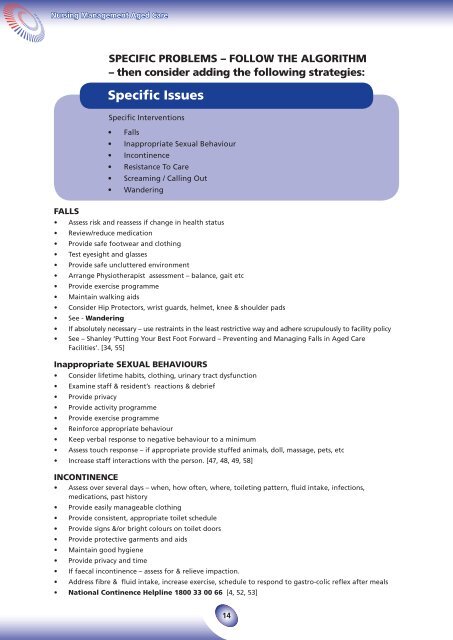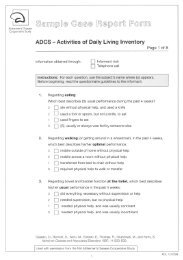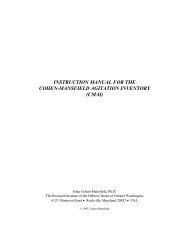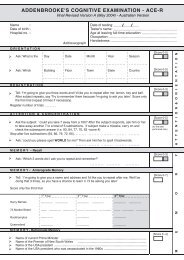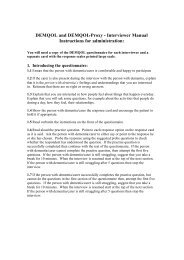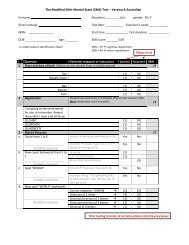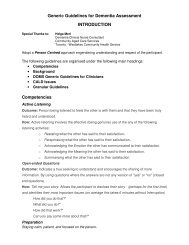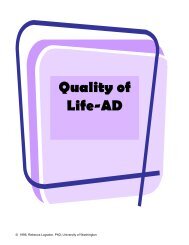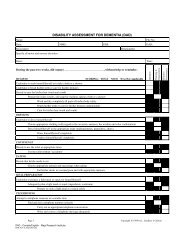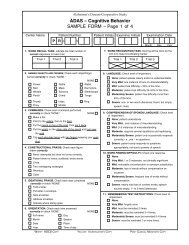Nursing Management of Disturbed Behaviour in Aged Care Facilities
Nursing Management of Disturbed Behaviour in Aged Care Facilities
Nursing Management of Disturbed Behaviour in Aged Care Facilities
Create successful ePaper yourself
Turn your PDF publications into a flip-book with our unique Google optimized e-Paper software.
<strong>Nurs<strong>in</strong>g</strong> <strong>Management</strong> <strong>Aged</strong> <strong>Care</strong><br />
FALLS<br />
SPECIFIC PROBLEMS – FOLLOW THE ALGORITHM<br />
– then consider add<strong>in</strong>g the follow<strong>in</strong>g strategies:<br />
• Assess risk and reassess if change <strong>in</strong> health status<br />
• Review/reduce medication<br />
• Provide safe footwear and cloth<strong>in</strong>g<br />
• Test eyesight and glasses<br />
• Provide safe uncluttered environment<br />
• Arrange Physiotherapist assessment – balance, gait etc<br />
• Provide exercise programme<br />
• Ma<strong>in</strong>ta<strong>in</strong> walk<strong>in</strong>g aids<br />
• Consider Hip Protectors, wrist guards, helmet, knee & shoulder pads<br />
• See - Wander<strong>in</strong>g<br />
• If absolutely necessary – use restra<strong>in</strong>ts <strong>in</strong> the least restrictive way and adhere scrupulously to facility policy<br />
• See – Shanley ‘Putt<strong>in</strong>g Your Best Foot Forward – Prevent<strong>in</strong>g and Manag<strong>in</strong>g Falls <strong>in</strong> <strong>Aged</strong> <strong>Care</strong><br />
<strong>Facilities</strong>’. [34, 55]<br />
Inappropriate SEXUAL BEHAVIOURS<br />
• Consider lifetime habits, cloth<strong>in</strong>g, ur<strong>in</strong>ary tract dysfunction<br />
• Exam<strong>in</strong>e staff & resident’s reactions & debrief<br />
• Provide privacy<br />
• Provide activity programme<br />
• Provide exercise programme<br />
• Re<strong>in</strong>force appropriate behaviour<br />
• Keep verbal response to negative behaviour to a m<strong>in</strong>imum<br />
• Assess touch response – if appropriate provide stuffed animals, doll, massage, pets, etc<br />
• Increase staff <strong>in</strong>teractions with the person. [47, 48, 49, 58]<br />
INCONTINENCE<br />
• Assess over several days – when, how <strong>of</strong>ten, where, toilet<strong>in</strong>g pattern, fluid <strong>in</strong>take, <strong>in</strong>fections,<br />
medications, past history<br />
• Provide easily manageable cloth<strong>in</strong>g<br />
• Provide consistent, appropriate toilet schedule<br />
• Provide signs &/or bright colours on toilet doors<br />
• Provide protective garments and aids<br />
• Ma<strong>in</strong>ta<strong>in</strong> good hygiene<br />
• Provide privacy and time<br />
Specific Issues<br />
Specific Interventions<br />
• Falls<br />
• Inappropriate Sexual <strong>Behaviour</strong><br />
• Incont<strong>in</strong>ence<br />
• Resistance To <strong>Care</strong><br />
• Scream<strong>in</strong>g / Call<strong>in</strong>g Out<br />
• Wander<strong>in</strong>g<br />
• If faecal <strong>in</strong>cont<strong>in</strong>ence – assess for & relieve impaction.<br />
• Address fibre & fluid <strong>in</strong>take, <strong>in</strong>crease exercise, schedule to respond to gastro-colic reflex after meals<br />
• National Cont<strong>in</strong>ence Helpl<strong>in</strong>e 1800 33 00 66 [4, 52, 53]


